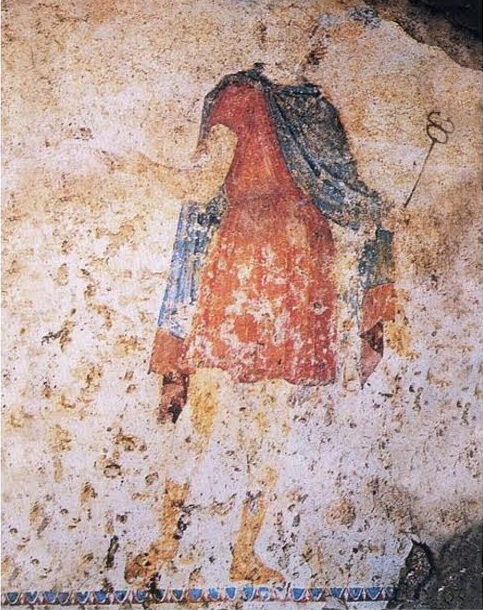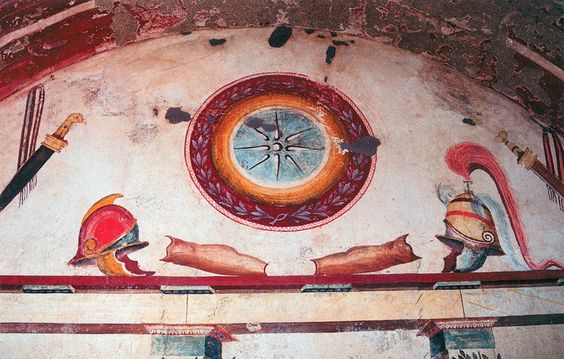Many people--myself included--sometimes forget how extensive the ancient Hellenic empire was. It wasn't just what is now modern Greece. It extended all the way down to, for example, Russia, Italy, Spain and the Ukraine. But, of course, there were ancient Hellenic cities in modern day Greece too that no longer exist today. One of these is Mieza.
At the foot of mount Vermio in Central Macedonia, Greece, excavations brought to light and continue to reveal the remains of an ancient city, which is identified with Mieza, one of the major cities of the Macedonian kingdom the period of its prosperity (4th to 2nd century BC). There are numerous references for Mieza at ancient literary sources, most notably Plutarch's information that near the ancient city lay Nymphaion, in the shady paths of which Aristotle taught the young Alexander the Great.
Mieza was a rural community that transformed into an urban center, then into a prosperous and wealthy city of the Hellenistic period. The most valuable archaeological evidence derives from the cemeteries and burial monuments of the area, which preserved the second most significant complex of Macedonian tombs after the royal tombs of Vergina. A total of six Macedonian tombs were found along the course of the road that in antiquity led from Pella to Mieza. They bear all the typical features of the monumental Macedonian tombs, they namely are subterranean vaulted structures with a temple-like façade and one or two burial chambers. Most often the internal surfaces, as well as the façade bear painted decoration and it is noteworthy that the murals of the Macedonian tombs are so far the only preserved examples of the large-scale ancient Greek painting. The tombs used to be covered with soil to form a hill and formed the resting places of the royal dynasty.
Perhaps the most important amongst all known Macedonian tombs is the Tomb of Judgement (late 4th - early 3rd century BC), one of the largest and most imposing monuments of its kind. Unique is the exterior of the tomb articulated by a two-storey façade which combines the Doric order in the lower half and the Ionic in the upper half respectively. Among the Doric half-columns flanking the door of the tomb are four paintings, depicting Hermes Psychopompos leading the dead to the Judges of the Underworld. The Doric metopes depict scenes of the Kentauromakhy while the war scene of the Ionic frieze with its relief figures represents one of the historic battles of Greeks and Persians.
Outside the perimeter of the ancient city, along the contemporary rural road that leads from Kopanos to Naoussa, lies the idyllic site of Isvoria. The lush landscape with the plenty waters and natural caves on the rocks was an ideal place for worshipping the Nymphs in antiquity. The scattered architectural parts of a rock-hewn Ionic stoa, dated after the mid-4rth century BC, were associated with the ancient descriptions and led to the identification of a significant site: the very school of Aristotles, where the young prince Alexander studied under the great philosopher.
The ancient city itself consists of disperse building complexes, though its boundaries cannot yet be delineated with precision. The architectural remains belong mainly to buildings of a public character and it’s most likely that the nucleus of the ancient city, namely its agora, lay at the present rural site of Belovina at Kopanos, where the theatre also came to light. The theatre dates to the Late Hellenistic period, though the form in which it is preserved today belongs to the Roman times. It was built on a hillside with a panoramic view over the valley and its capacity is estimated at 1500 spectators. The prosperity of Mieza is also reflected in the luxurious villas of the Hellenistic and Roman times. Among the best preserved examples are the two Roman villas at Tsifliki of Lefkadia and Baltaneto of Naoussa respectively, with splendid mosaic floors dated to the 2nd century AD.
[Can't find it? Little left and below of center,
under "Bottia"]
At the foot of mount Vermio in Central Macedonia, Greece, excavations brought to light and continue to reveal the remains of an ancient city, which is identified with Mieza, one of the major cities of the Macedonian kingdom the period of its prosperity (4th to 2nd century BC). There are numerous references for Mieza at ancient literary sources, most notably Plutarch's information that near the ancient city lay Nymphaion, in the shady paths of which Aristotle taught the young Alexander the Great.
[Excavations of the "Aristotle School" near Naousa]
Mieza was a rural community that transformed into an urban center, then into a prosperous and wealthy city of the Hellenistic period. The most valuable archaeological evidence derives from the cemeteries and burial monuments of the area, which preserved the second most significant complex of Macedonian tombs after the royal tombs of Vergina. A total of six Macedonian tombs were found along the course of the road that in antiquity led from Pella to Mieza. They bear all the typical features of the monumental Macedonian tombs, they namely are subterranean vaulted structures with a temple-like façade and one or two burial chambers. Most often the internal surfaces, as well as the façade bear painted decoration and it is noteworthy that the murals of the Macedonian tombs are so far the only preserved examples of the large-scale ancient Greek painting. The tombs used to be covered with soil to form a hill and formed the resting places of the royal dynasty.
[Facade of the "Tomb of Judgment"]
Perhaps the most important amongst all known Macedonian tombs is the Tomb of Judgement (late 4th - early 3rd century BC), one of the largest and most imposing monuments of its kind. Unique is the exterior of the tomb articulated by a two-storey façade which combines the Doric order in the lower half and the Ionic in the upper half respectively. Among the Doric half-columns flanking the door of the tomb are four paintings, depicting Hermes Psychopompos leading the dead to the Judges of the Underworld. The Doric metopes depict scenes of the Kentauromakhy while the war scene of the Ionic frieze with its relief figures represents one of the historic battles of Greeks and Persians.
[Fresco from the Tomb of Judgment showing Hermes Psychopompos]
Outside the perimeter of the ancient city, along the contemporary rural road that leads from Kopanos to Naoussa, lies the idyllic site of Isvoria. The lush landscape with the plenty waters and natural caves on the rocks was an ideal place for worshipping the Nymphs in antiquity. The scattered architectural parts of a rock-hewn Ionic stoa, dated after the mid-4rth century BC, were associated with the ancient descriptions and led to the identification of a significant site: the very school of Aristotles, where the young prince Alexander studied under the great philosopher.
[Painting from the Tomb of Lyson and Kallikles (2nd BC)]
The ancient city itself consists of disperse building complexes, though its boundaries cannot yet be delineated with precision. The architectural remains belong mainly to buildings of a public character and it’s most likely that the nucleus of the ancient city, namely its agora, lay at the present rural site of Belovina at Kopanos, where the theatre also came to light. The theatre dates to the Late Hellenistic period, though the form in which it is preserved today belongs to the Roman times. It was built on a hillside with a panoramic view over the valley and its capacity is estimated at 1500 spectators. The prosperity of Mieza is also reflected in the luxurious villas of the Hellenistic and Roman times. Among the best preserved examples are the two Roman villas at Tsifliki of Lefkadia and Baltaneto of Naoussa respectively, with splendid mosaic floors dated to the 2nd century AD.
-
Monday, July 10, 2017
Ancient Cities Collection ancient Hellenic culture Aristotle Centauromachy Hermes Psychopompos






No comments:
Post a Comment